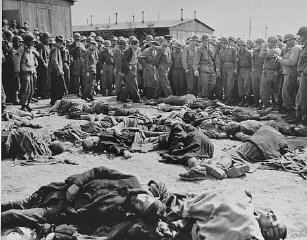As Allied and Soviet troops moved across Europe in a series of offensives against Nazi Germany, they encountered concentration camps, mass graves, and numerous other sites of Nazi crimes. Soviet forces were the first to overrun a major Nazi concentration camp, Lublin/Majdanek, near Lublin, Poland, in July 1944. On January 27, 1945, Soviet troops liberated the Auschwitz concentration camp complex, where they discovered some 7,000 prisoners, including young children, who had not been evacuated by the SS. American soldiers, too, witnessed evidence of the Holocaust and Nazi atrocities as they marched into the interior of Germany, liberating the major concentration camps such as Buchenwald, Dachau, and Mauthausen as well as hundreds of subcamps, including Ohrdruf (a subcamp of Buchenwald). Though the liberation of Nazi camps was not a primary objective of the Allied military campaign, U.S, British, Canadian, and Soviet troops freed prisoners from their SS guards, provided them with food and badly needed medical support, and collected evidence for war crimes trials.
On May 8, 1945, less than one year after D-Day, Nazi Germany's unconditional surrender became official, and the world could celebrate the liberation of Europe from Nazi rule.

